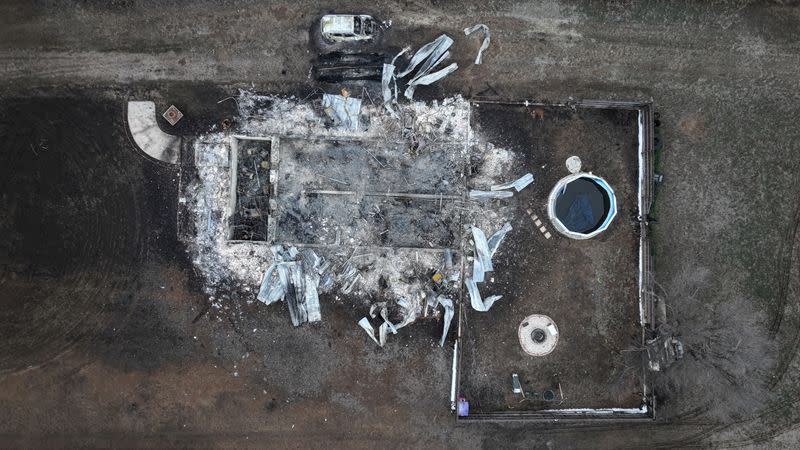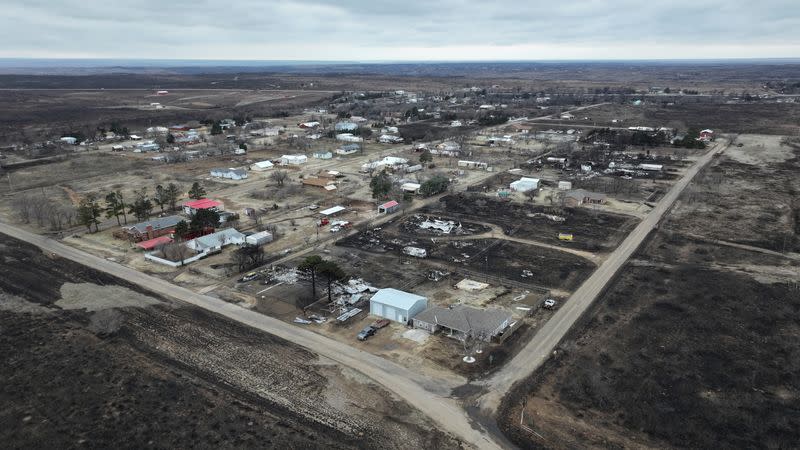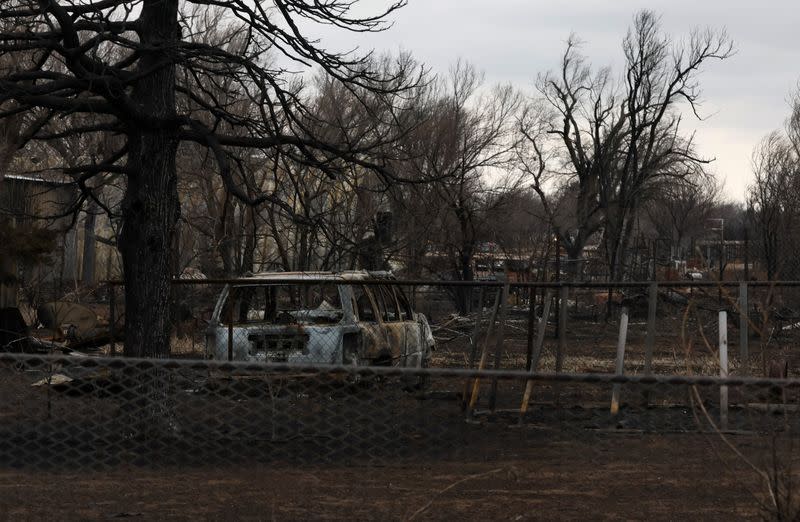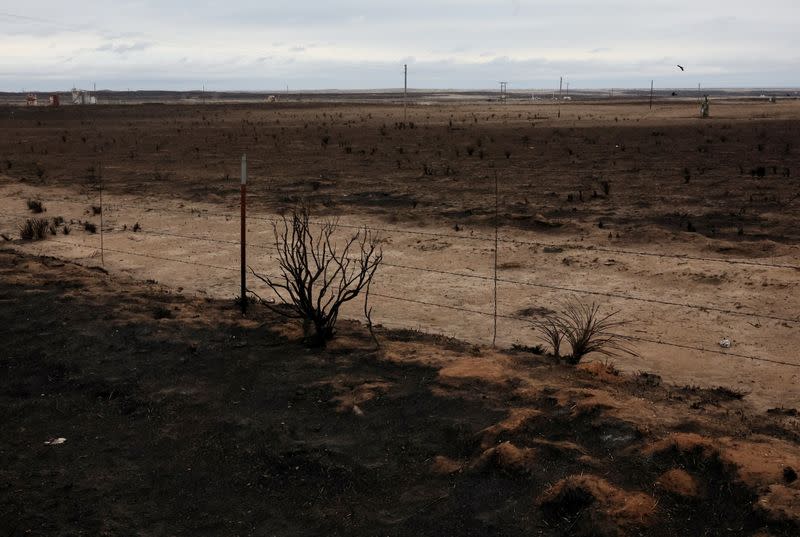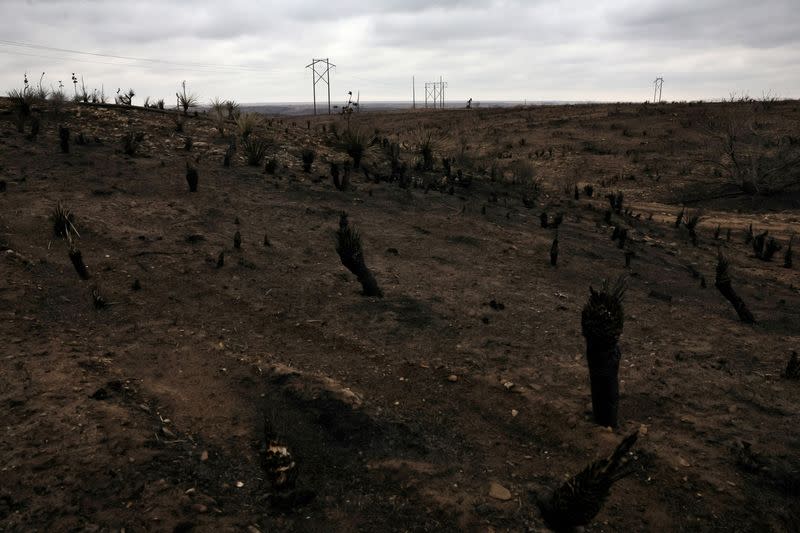Texas Panhandle firefighters battle blaze before wind gusts return
By Leah Millis, Nathan Frandino and Rich McKay
CANADIAN, Texas (Reuters) -Fire crews in the Texas Panhandle on Friday were battling to get a tighter grip on the state's largest wildfire on record, hoping to capitalize on a lull in incessant wind gusts that have fanned an inferno that has devastated the cattle-ranching region.
The deadly wildfire, dubbed the Smokehouse Creek Fire, has scorched more than 1 million acres (404,685 hectares), according to the latest figures from the Texas A&M Forest Service, provided on Thursday.
"Terrible is not strong enough of a word," said Terrill Bartlett, owner of a family-run lumber company who serves as mayor of Canadian, Texas, the epicenter of the sprawling blaze. "The ground is just black in all directions."
Since Monday, the fire has spread eastward across the Panhandle, pushing across the state's border with Oklahoma. In its wake it has left at least two people dead, dozens of torched homes and hundreds of square miles of scorched grazing land.
While firefighters have gained a measure of control over the blaze, the danger has not passed, with the wind expected to pick up over the weekend, said Sean Dugan, a spokesperson for the Texas A&M Forest Service.
"We're looking at the next few hot, dry days that will be windy," he said. "Those heavy fuels will come back alive with dry and windy weather, kicking up embers and ... carry them over into unburned fuel."
Between 400 and 500 structures have been destroyed so far, based on a "premature assessment" that would likely change, Texas Governor Gregg Abbott said at a news briefing on Friday.
"We face enormous potential fire dangers as we head into this weekend," Abbott said. "No one can let down their guard."
Earlier, Canadian's fire chief, Scott Brewster, said 109 homes were destroyed in the town and surrounding Hemphill County, as well as an unspecified number of other structures.
W. Nim Kidd, chief of the Texas Division of Emergency Management, said at the briefing that it was difficult to assess full damages with the fire still smoldering.
Kidd did not update the number of acres burned and the level of containment achieved by fire crews, saying he did not want to give people false confidence.
Earlier on Friday, Texas A&M's Dugan said containment was conservatively estimated at 5%, up from 3% on Thursday.
SCENES OF DEVASTATION
The once-fertile grasslands around Canadian looked more like a war zone on Friday, with thousands of cattle corpses littering the charred fields, according to Wes Avent, who owns a local ranch supply store.
Avent turned his store into a makeshift station for distributing donated feed, fencing and other supplies to ranchers.
"Right now our biggest chore is to get feed to the cattle that survived," he said. "We've got to get feed and hay out to these guys as fast as we can."
A miles-long line of tractor trailers snaked along the highway into Canadian on Friday, waiting to deliver bales of cattle feed and other supplies to desperate ranchers.
The two people killed in the wildfire included a woman who succumbed to her injuries on Thursday, her family said on GoFundMe.com. She was rushed to a burn center in Oklahoma City after she was overcome with smoke and flames while driving her truck in Pampa, Texas, on Tuesday, local news reported.
An 83-year-old woman in Hutchinson County, northeast of Amarillo, was also killed in the fire, according to local media.
"As far as cattle, I don't think anyone knows yet," said Brewster, the fire chief. "I talked to one rancher and he said he lost 700 cattle. And that's just one guy. There's no telling what the tally will be, but it'll be up there."
Over the weekend, the weather forecast for the Texas Panhandle calls for no rain and winds of up to 45 miles (72 km) per hour, said Bob Oravec, a meteorologist with the National Weather Service's Weather Prediction Center in College Park, Maryland.
"These are ingredients for more fire," Oravec said. "The winds have no moisture content coming from the southwest. It dries out the stuff that burns."
According to the latest Texas A&M Forest Service numbers, the Smokehouse Creek Fire has now burned through 1.08 million acres (437,060 hectares), or nearly 1,700 square miles, an area larger than New York's Long Island. That replaced a 2006 fire that charred about 900,000 acres (364,220 hectares) as the most expansive in state history.
Several smaller wildfires were burning in other parts of the Panhandle. The next largest, the Windy Deuce fire, has burned 142,000 acres (57,470 hectares) and was 50% contained on Friday, according to Texas A&M.
(Reporting by Leah Millis in Canadian, Texas; Nathan Frandino in Borger, Texas; Brendan O'Brien in Chicago and Rich McKay in Atlanta; Editing by Frank McGurty and Jonathan Oatis)

